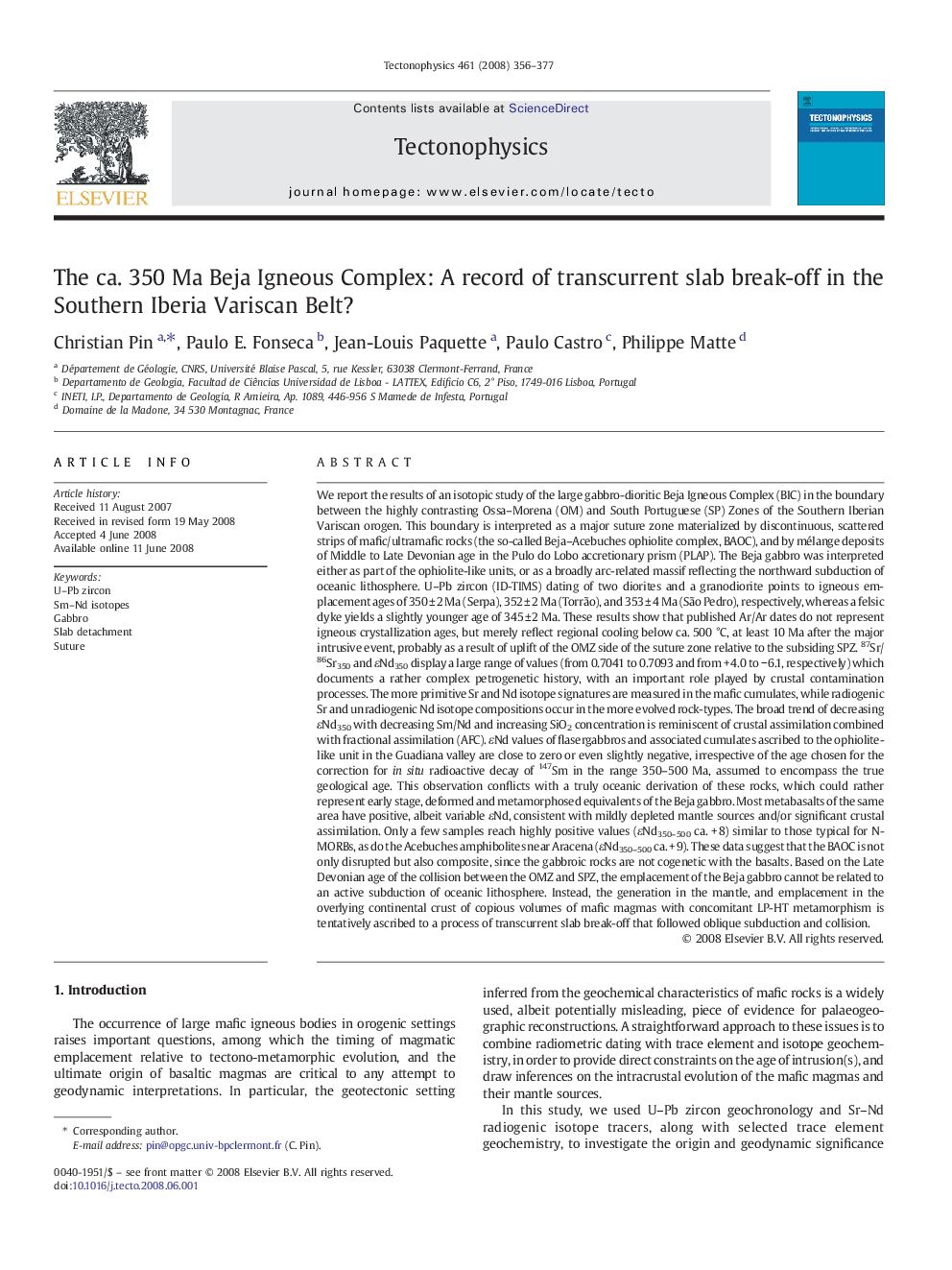| کد مقاله | کد نشریه | سال انتشار | مقاله انگلیسی | نسخه تمام متن |
|---|---|---|---|---|
| 4694194 | 1636904 | 2008 | 22 صفحه PDF | دانلود رایگان |

We report the results of an isotopic study of the large gabbro-dioritic Beja Igneous Complex (BIC) in the boundary between the highly contrasting Ossa–Morena (OM) and South Portuguese (SP) Zones of the Southern Iberian Variscan orogen. This boundary is interpreted as a major suture zone materialized by discontinuous, scattered strips of mafic/ultramafic rocks (the so-called Beja–Acebuches ophiolite complex, BAOC), and by mélange deposits of Middle to Late Devonian age in the Pulo do Lobo accretionary prism (PLAP). The Beja gabbro was interpreted either as part of the ophiolite-like units, or as a broadly arc-related massif reflecting the northward subduction of oceanic lithosphere. U–Pb zircon (ID-TIMS) dating of two diorites and a granodiorite points to igneous emplacement ages of 350 ± 2 Ma (Serpa), 352 ± 2 Ma (Torrão), and 353 ± 4 Ma (São Pedro), respectively, whereas a felsic dyke yields a slightly younger age of 345 ± 2 Ma. These results show that published Ar/Ar dates do not represent igneous crystallization ages, but merely reflect regional cooling below ca. 500 °C, at least 10 Ma after the major intrusive event, probably as a result of uplift of the OMZ side of the suture zone relative to the subsiding SPZ. 87Sr/86Sr350 and εNd350 display a large range of values (from 0.7041 to 0.7093 and from + 4.0 to − 6.1, respectively) which documents a rather complex petrogenetic history, with an important role played by crustal contamination processes. The more primitive Sr and Nd isotope signatures are measured in the mafic cumulates, while radiogenic Sr and unradiogenic Nd isotope compositions occur in the more evolved rock-types. The broad trend of decreasing εNd350 with decreasing Sm/Nd and increasing SiO2 concentration is reminiscent of crustal assimilation combined with fractional assimilation (AFC). εNd values of flasergabbros and associated cumulates ascribed to the ophiolite-like unit in the Guadiana valley are close to zero or even slightly negative, irrespective of the age chosen for the correction for in situ radioactive decay of 147Sm in the range 350–500 Ma, assumed to encompass the true geological age. This observation conflicts with a truly oceanic derivation of these rocks, which could rather represent early stage, deformed and metamorphosed equivalents of the Beja gabbro. Most metabasalts of the same area have positive, albeit variable εNd, consistent with mildly depleted mantle sources and/or significant crustal assimilation. Only a few samples reach highly positive values (εNd350–500 ca. + 8) similar to those typical for N-MORBs, as do the Acebuches amphibolites near Aracena (εNd350–500 ca. + 9). These data suggest that the BAOC is not only disrupted but also composite, since the gabbroic rocks are not cogenetic with the basalts. Based on the Late Devonian age of the collision between the OMZ and SPZ, the emplacement of the Beja gabbro cannot be related to an active subduction of oceanic lithosphere. Instead, the generation in the mantle, and emplacement in the overlying continental crust of copious volumes of mafic magmas with concomitant LP-HT metamorphism is tentatively ascribed to a process of transcurrent slab break-off that followed oblique subduction and collision.
Journal: Tectonophysics - Volume 461, Issues 1–4, 1 December 2008, Pages 356–377